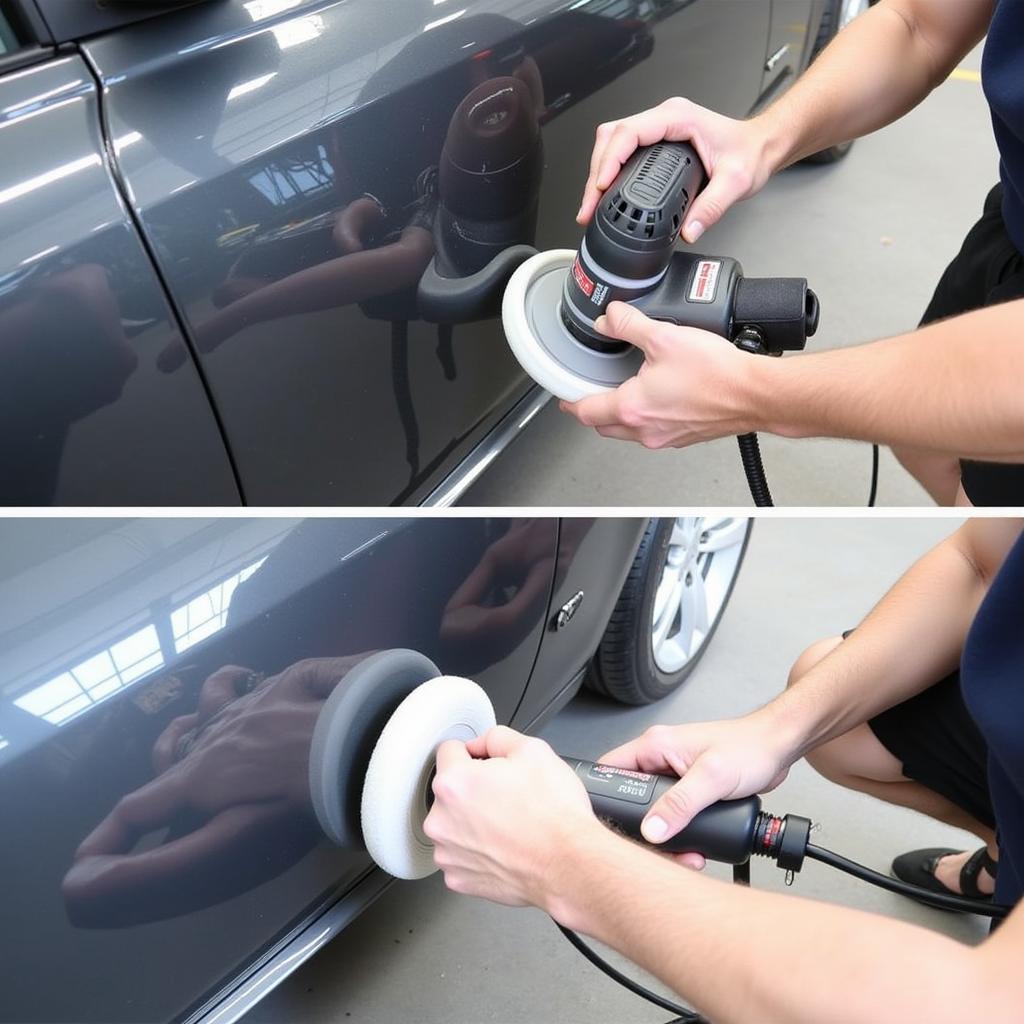Car Detailing Best Practices are essential for maintaining your vehicle’s appearance and preserving its value. Whether you’re a seasoned detailer or just starting out, understanding the key principles and techniques will help you achieve professional-level results. From proper washing and drying to paint correction and protection, this guide covers everything you need to know to elevate your car detailing game.
Washing and Drying: The Foundation of Car Detailing Best Practices
A thorough wash and dry is the first and most crucial step in any car detailing process. Using the wrong techniques can introduce swirl marks and scratches, negating the benefits of subsequent detailing steps. Start by rinsing the car with a pressure washer to remove loose dirt and debris. Then, use a two-bucket wash method: one bucket with soapy water and another with clean water for rinsing your wash mitt. This prevents cross-contamination and minimizes the risk of scratching. Work from top to bottom, washing one section at a time. Finally, dry the car with a high-quality microfiber drying towel, using gentle blotting motions rather than dragging.
Paint Correction: Removing Imperfections for a Flawless Finish
Paint correction involves removing imperfections like swirl marks, scratches, and etching from the paint surface. This process can significantly enhance the gloss and clarity of your car’s paint, making it look brand new. Depending on the severity of the imperfections, different techniques and tools are employed, ranging from clay barring and chemical decontamination to polishing with a dual-action polisher. For beginners, it’s recommended to start with less aggressive methods and gradually move to more advanced techniques as your skills improve. Like car detailing for beginnners best products, paint correction requires patience and attention to detail.
Understanding Different Polishing Techniques
There are several polishing techniques, each suited for a particular type of imperfection. Compounding is the most aggressive method, used for removing deep scratches and swirl marks. Polishing, on the other hand, is less aggressive and focuses on refining the paint surface and removing minor imperfections. Finally, jeweling is the least aggressive step, designed to maximize gloss and clarity. Choosing the right technique is crucial for achieving the desired results without damaging the paint.
 Car Paint Correction Process with Polishing Machine
Car Paint Correction Process with Polishing Machine
Protection: Safeguarding Your Car’s Finish
After achieving a flawless finish through washing and paint correction, the next crucial step is protection. This involves applying a protective layer to the paint surface to shield it from environmental contaminants, UV rays, and minor scratches. The most common types of protection include waxes, sealants, and ceramic coatings. Waxes offer a warm, natural shine and are relatively easy to apply. Sealants provide longer-lasting protection and a more durable finish. Ceramic coatings offer the highest level of protection and durability, but they require more specialized application techniques. Choosing the right protection depends on your budget, desired level of protection, and maintenance preferences. This is as important as finding the best car detailing spray bottles.
Wax vs. Sealant vs. Ceramic Coating: Choosing the Right Protection
Each type of protection offers unique benefits and drawbacks. Wax provides a deep, glossy shine but typically lasts only a few months. Sealant offers longer-lasting protection, up to six months or more, with a slick, reflective finish. Ceramic coatings, on the other hand, can provide protection for several years, offering exceptional durability and resistance to environmental contaminants. Understanding the differences between these options will help you make an informed decision based on your needs. You may find similarities between this decision making process and choosing the best car wash and detailing service.
Interior Detailing: Maintaining a Pristine Cabin
Interior detailing involves cleaning and protecting the interior surfaces of your car, including the seats, carpets, dashboard, and door panels. Start by vacuuming the entire interior to remove loose dirt and debris. Then, use appropriate cleaners and protectants for different surfaces. For leather seats, use a dedicated leather cleaner and conditioner. For fabric seats, use a fabric cleaner and protectant. Clean the dashboard and other interior trim with a suitable interior cleaner. Finally, apply a protectant to help maintain the appearance and prevent fading and cracking. For those located in specific regions, resources like best car detailing in minnesota or best car detailing in atlanta can be very helpful in finding specialized services.
Conclusion: Mastering Car Detailing Best Practices
By following these car detailing best practices, you can transform your vehicle’s appearance and preserve its value for years to come. Remember that proper washing and drying, paint correction, and protection are the key elements of a successful car detailing process. With patience, practice, and the right tools and techniques, you can achieve professional-level results and enjoy a showroom-worthy shine.
FAQ
- What is the best way to wash my car?
- How often should I wax my car?
- What is the difference between a sealant and a ceramic coating?
- How can I remove swirl marks from my car’s paint?
- What are the best products for interior detailing?
- How can I protect my car’s interior from UV damage?
- What is the best way to dry my car after washing it?
Need more assistance with car detailing best practices? Explore more articles on our website for additional tips and insights.
For immediate support, contact us via WhatsApp: +1(641)206-8880, or Email: [email protected]. Our customer service team is available 24/7.

Leave a Reply